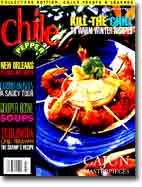 |
|
EXTREME HEAT: KEY WEST’S CARIBE SOUL
Published in Chili Pepper Magazine, February 2001
On cold winter nights, don’t go South of the Border to warm up more than your mouth, go south of Miami to the Florida Keys. This 150-mile string of islands stapled together by 70 or so bridges is the only place in the Continental US that never freezes. Never.
Where the Overseas Highway dead-ends in Key West, Cuba is closer than Miami. Sure, English is spoken here, but in this easily accessed, passport-free corner of the Caribbean cultures merge and island-time prevails. Electric cars and scooters max out at 30 mph. Go-fast boats cozy up to kayaks at dockside bars. Sarongs go the distance from beach-ware to formal wedding gowns.
In these parts, extremes happen. Chefs Michael Weston and Kevin Robinson understand polarity. They know Caribbean cuisine may be as limp as Bahamian black peas, or as feisty as Cajun and Creole cuisine. At Caribe Soul, their hot little restaurant in Key West, culinary heat is akin to summertime sunrays. Here, extreme heat happens.
Now extreme heat doesn’t necessarily mean you blow out your sinuses with the first bite. Caribe Soul’s “Voodoo Sauce” is zesty, to be sure. It won second place in the Best New Products category of Chile Pepper Magazine’s 2000 Fiery Food Challenge. But “our hottest sauce ever debuts at the 2001 Challenge,” said Chef Weston, a transplant from our nation’s capital, who boasts a Georgia-Jamaica family tree. “We'll make anything as hot as you want, but instant scald is senseless. As with all our food, flavor comes first, then the heat.”
Indeed, savor the subtlety of tuna then push the limits of flavor with exotic fruits, spices and peppers. Such extremes are Key West legends; from pirates and brothels to world-class resorts. Today, more than 200 restaurants fatten the two-by-four mile island that caters to seasonal tourism. Off-season, locals weed out anything inferior. “New starts” are formidable, even to experienced restaurateurs.
Weston and Robinson noted the competition and eased into their business backward from most chefs: the food store preceded the restaurant. In March 1996, Kitchens of Caribe Soul began concocting products like “Bahama Hot” sauce and a Vidalia onion-based “House Dressing”. Weston’s Deep South and down-island heritage fit snugly with Robinson's Tex-Mex background, and within six months, the sauce shop mushroomed into a locals’ favorite restaurant. Homemade sauces, salsas and seasonings put the cutting edge on a diverse home-cooked menu: “The tastes in our products are as wide ranging as the cuisine we each grew up with; all of it spicy and flavorful,” said Weston.
Caribe Soul is the ultimate island melting pot. Everything Bahamian, Bermudian, Jamaican, French Antillean, even Caribbean Mexican blends sensually. The mesh is as subtle as the influence of African slaves on all the foods in the Caribbean, yet as explosive as Caribe Soul’s spicy green beans side dish.
Although these chefs prefer to taunt fire-eaters with the slow build of pepper power, their décor is, well, extreme. Little Stevie Wonder could not miss the elegance of the British Caribbean Bar Room, or the “Don’t Worry, Be Happy” ambiance in the Jamaican Blue Crab Bar. In the first, clues are blatant; bamboo, ceiling fans, antiques from India. The feel is Explorer’s Society from, say, 1893. In the second, clues are blatant: stripes and patterns support beach umbrellas with no particular purpose other than flaming reds and blazing blues and sea greens.
Chef Robinson's original art compliments the positive mental attitude oozing from the 150-seat restaurant. A fine artist in and out of the kitchen, his giant, broken glass mural on the outdoor patio separates upscale-British from get-rowdy-Jamaican. But the artwork will someday give way to a series of French doors that expands the patio and turns the Jamaican Blue Crab Bar into a true pleasure of frost-free living: a year-round, indoor-outdoor dining room.
By Barbara Bowers, © 2000
|
|